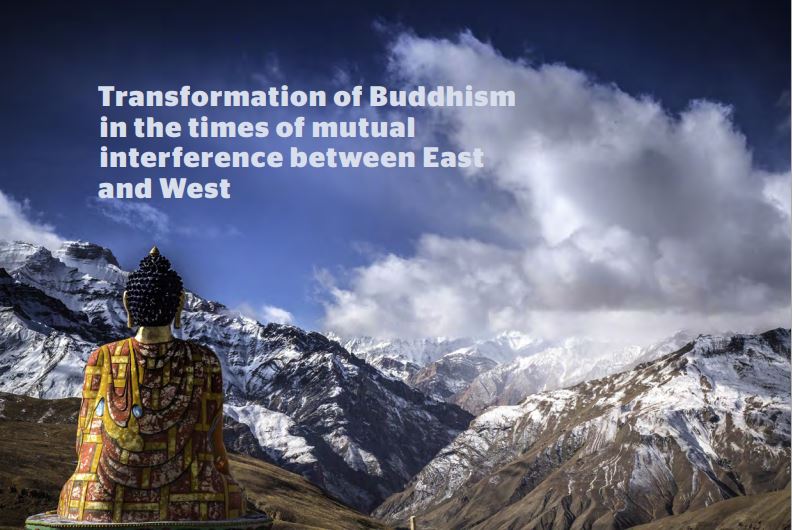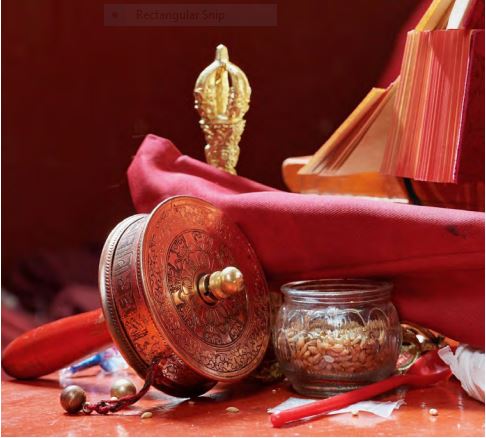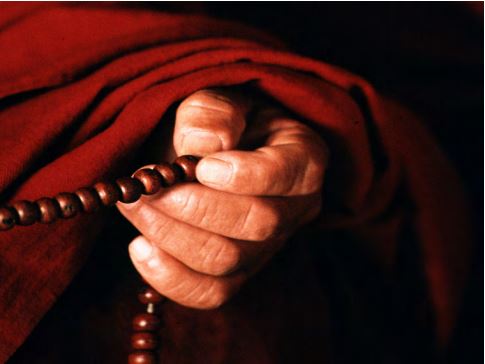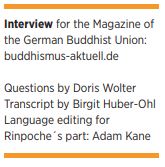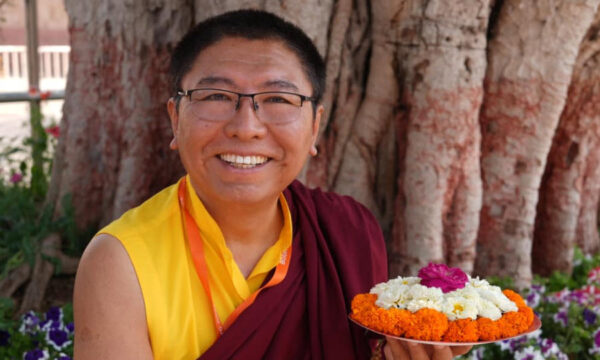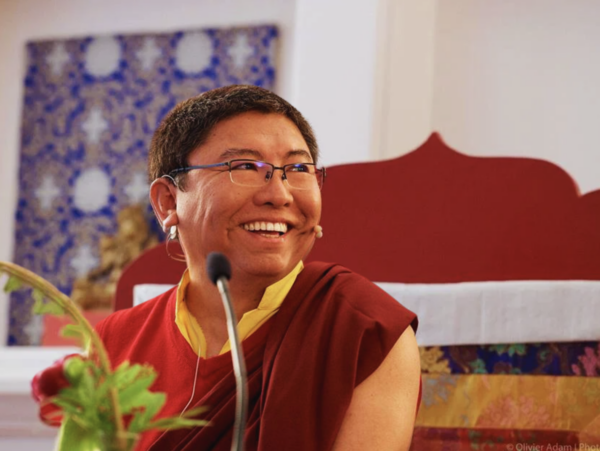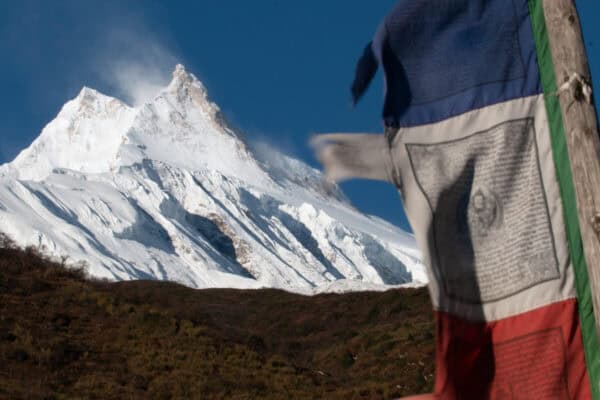Q: I want to ask a few questions about this context of the transformation Buddhism is taking these days, because there is a lot of interference and mutual influence from West and East, back and forth. I hope this interview benefits many beings.
So, you are frequently crossing borders between East and West, and I have heard that you are living in the US now.
Rinpoche: Definitely. Not full-time in the U.S., but coming and going.
What influence has the West had on you? And how has your own migration transformed you and the way you teach?
Rinpoche: Oh, many, many influences! Mainly insight . . . I’ll gain new insight from my students. Insight is insight. Truth is Truth. Wisdom is wisdom. I get wisdom from my teachers and from my own little practice. The combination, then, opens my eyes to many things: “Oooh, this is the way! That’s it!” Then I put these two things together, insight and wisdom, and try to help my friends and students. Seems like it is helping.
That does not mean that I’m creating and sharing a completely new Buddhism. No, it’s the same old Buddhism. But the authentic Buddhism – it can be relevant to all the ways and situations in the world.
Wisdom is wisdom, whether it is newly discovered or discovered in the old days. The time is different. But what is actually discovered, the actual insight, is the same.
What was the Buddhist essence you kept even though you had lots of influence from the West?
Rinpoche: The essence is love, compassion and openness and freedom.
Thank you. And how can we Westerners learn how to distinguish between the essence of Buddhism and the cultural aspects? Do we already have a clear enough judgment to take away some of the aspects which we feel are cultural influence and therefore an unnecessary burden?
Rinpoche: I don’t know from the student’s side, it will take time. But every time a religion or Dharma establishes itself in one country, then it will have some of the culture. A way, a method, part of the Dharma will be adopted from that culture. Now Dharma is already in the West for almost 50 or 60 years, and it is already adapting to this new culture. It is a new Buddhist culture. So I am not worried, it will change. Those aspects are changeable, they should change. But the core teaching is not a culture, like some kind of Buddhist culture. It is actual fact and truth. And that is everywhere, beyond culture. But sometimes the old culture may be helpful for a while. So why not maintain that?
But many people like to do away with it quite quickly in the West, that`s why I ask that question.
Rinpoche: Well, if they find wisdom and compassion without the culture, then why not?
Do you see a responsibility for Westerners to keep the authenticity of the Dharma in the West?
Rinpoche: Of course, yes, definitely! That will evolve, eventually, from a combination of their practice and their experiences and working with good teachers. The depth of study and realization, and that authenticity will be born out of those and will remain. And then this will become attractive, they will become very attractive because dharma is a jewel. Everyone likes a jewel!
Yeah, it is true. So, in which way do Asian practitioners still impress you, and what could we in the West learn from them, as they have different qualities than us?
Rinpoche: Right. There is innermost flexibility, adaptability. They have a lack of reifying, solidifying everything, but enough to function. They have that.
But sometimes, of course, the modernization comes and then it changes a little bit. But the pure Asian environment has some Dharma, it’s already been practiced. They have this balance. They are happy, but not over-the-top kind of happy. Their happiness has essence love; it is grounded and has some appreciation. And they are not that aggressive, to get or become something. It’s kind of beautiful, like a flower; without any purpose, just blooming. I see that – not only in Asian Buddhists, I mean mountain people can have that. They are just living simply, not chasing something – and then with that the Dharma comes, and Dharma gives you some purpose and together with that, it is quite healthy.
Very good, thank you.
Many practices, like reciting long texts, stem from monastic traditions in Asia, which we often feel are not really fitting here, or we have problems adapting to that. How do you see the future of these forms of practice in the West and also long-term for the east?
Rinpoche: I think the elaborate forms, like elaborate chanting, will diminish, will be practiced less and less. And I think it will go back to the old Indian style. There’s just a few yidams, one or two deities, and then we connect with that and then chant a mantra. And a little bit of a short sadhana, and the sadhana is just a reminder for meditation. I think that will remain because mantra has power. It’s not culture only.
So this part I want to make clear: many people think mantra is a culture, but it is not a culture. It has its own unique power. So if you really practice Dharma in the Vajrayana way, sooner or later you will appreciate mantra. The power of mantra will have an effect on your practice.
Many of my students didn’t chant for many years. Then they started to study more and more about deity practice. The reason is that they actually like to chant. And they see, ooh, not the complex ones, but short sadhanas and mantras and the authentic way of visualization keeps them in the atmosphere of practice – with some reference point and then the referenceless.
Relative practice along with ultimate practice. So there is a better balance. Otherwise, if we just keep practicing Shamatha, Vipashyana and Dzogchen without any mantra, we can feel dry. Just like not much blessing. We need blessings. Blessing is not a culture. And pure mantra is not a culture. The core of mantra is part of the Mantrayana. not Indian culture, not Tibetan culture, not Chinese culture.
And the mantra is also emptiness. Emptiness also appears as mantras. Sounds are like empty forms.
Yes, all traditions have Mantra. In the German Buddhist Union, there are 67 different charities and they originally stem from all countries in the East. In a way, I see this German Buddhist Union with so many different practitioners from Theravada and all the traditions together trying to work out what the essence of Buddhism is, as a kind of a new Rime in the West.
Rinpoche: That is easy. The essence is easy: love, compassion, and peace. But then how you develop those qualities…we have all these different methods.
But also the Four Seals, Four Truths and all this we see as the essence.
Rinpoche: But if you want to bring all the methods together as one package, then you will not come together. But around the core, you can come together.
But to develop that core, that essential value, there are different methods. Let them grow by themselves. When they come down like a mantra, it’s a particular way of developing. But if you try to bring mantra into another one of the methods, one of the other forms of wisdom, then it can be a problem. Mantra is one of the ways to develop pure perception and clarity, and change our karmic perception. And there is where you can meet with other traditions. Ooh, karmic perception! Then they can understand what we are doing with mantra.
How to purify karmic perception? There is the Vipashyana way, Mantrayana way, Dzogchen way, Zen way, Theravadan way – there are these differences.
In your book “ Heiter und gelassen…,” [Open Heart, Open Mind] you obviously used methods from therapy. Other Buddhist teachers say: Therapy and Buddhism don`t go together. But with you, it seems to go together very well. Even though therapy in Western psychotherapy wants to build the ego and make it strong. But in Buddhism, the ego should be dissolved. So how does your method bring them together?
Rinpoche: Right. As I mentioned today, there is relative truth and ultimate truth. Relative truth can have distortion, we call that the distorted relative. And we have to bring that distorted relative to a healthy state. And so we need therapy – Buddhist flavored therapy or normal therapy, to make the distorted relative healthy. Otherwise, if you bring Buddhist methods to the distorted relative, you can mess things up. You can destroy their life, actually. You can destroy someone’s life. So it can be better to not give any Buddhist practice. This can be better.
But also, we cannot say, “Oh no, I am not going to give you any Buddhism,” that is also not nice. It is unkind. You have to be kind to everyone. Whoever wants to practice Dharma, they should get something. “Oh no, you are not healthy, so I’m not going to give you any Dharma practice”– that is not kind. So you give something. You make them healthy. You can give handshake practice with discernment: “Oh, how much of this issue is mine? How much is out there? What is the monster here? The monster is not me! It is just my leftover imprint, and I’m suffering from that. Something happened in my learned habitual patterns.” So we can hug those issues. And there we use the Buddhist methods. We understand by the methods of modern therapy, but wherever we transform, we use a Buddhist method. This is what I’m doing – mixing, mixing together.
The description from therapy can be very accurate. It is about learned habitual patterns. We usually only talk about karmic habitual patterns. But there are also learned habitual patterns from childhood until now. It obviously affects us. In Tibetan Buddhism, we call these “conditions.” We talk about causes and conditions. Causes come from past lives, conditions from this life. But we often don’t especially work with our learned habitual patterns.
We want to not learn, unlearn habitual patterns, isn`t it? Get rid of the patterns?
Rinpoche: The patterns are the learned habitual patterns, we learn them from childhood. Some habitual patterns are healthy, some are not healthy. The work of therapy is to make the unhealthy ones healthy. It’s the same for Buddhism.
So could Buddhism as a whole be seen as the ultimate therapy?
Rinpoche: I don`t want to give that kind of name, you know. We all work together.
You have a general message for Western Buddhists?
Rinpoche: Oh, just always … find essence love, our inner well-being. Find basic okay-ness. In the subtle body, in the feeling world. Not in the head. Bring Dharma into the feeling world. We are too much in our heads.
In the West we are educated to question authorities and to have a critical mind towards certain powers. And in a way, we seem to have lost a positive view of authority. So what would be a modern teacher-student relationship?
Rinpoche: I think it is to ask questions. If the student is sincere, and if the teacher is good, then you can ask any question. There should not be any problem with asking questions. And then, the teacher has a right to answer or not. Everyone has their own rights. Students have their rights. And traditionally also, students can check the teacher for nine years. But nowadays we don’t have time for that much checking.
And some didn’t know that. They immediately grab a teacher.
Rinpoche: Some didn’t know that. I mean, if you go through the old tradition, students checked teachers for nine years, and the teachers checked the students for nine or twelve years! Of course, we don’t follow all of that right now. But if it is a good teacher, we can ask them any question, and they are fine with that.
Great, Thank you very much, Rinpoche, thank you.
Lerab Ling, Summer 2019

